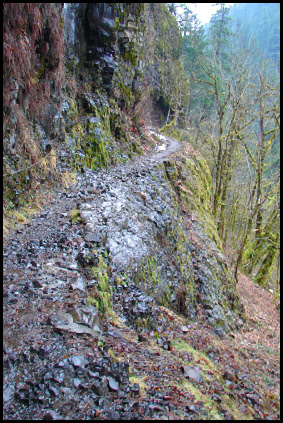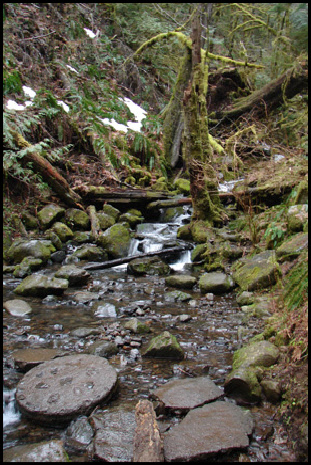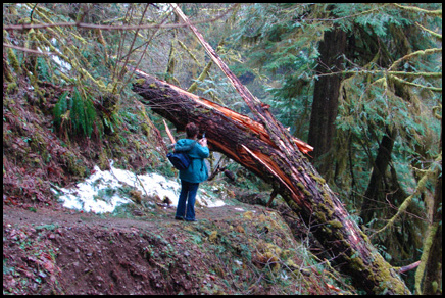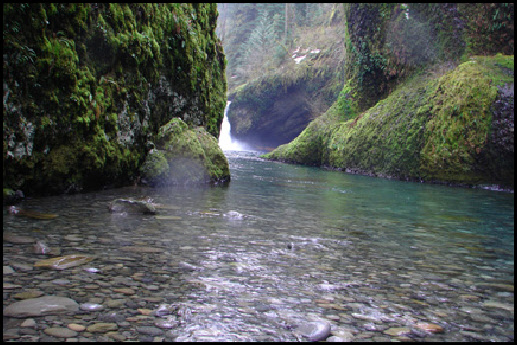
On the Trail
The trail is muddy and curving and it disappears around the bend, but we trust that it continues, even though our view ahead is of empty space. The creek is far below now, with glinting whitecaps as it flows over rocks, but we can barely glimpse it through the tangle of tree top branches.
We meet a few other hikers and a jogger. We pass a man and a woman on the way back from their hike, with a dog, I’m happy to see, on a leash. I have heard too many stories of unleashed dogs that have gone off the edge up here, never to return
The path has straightened out now and we are surrounded by trees again. We cross a small creek that is tumbling down to join Eagle creek on its route to the Columbia River.
A big Douglas Fir has recently fallen, cracked itself wide open, the inner wood still bright and clean, and is blocking the trail. We scramble under it, and I see that it has taken some branches of a nearby Western Red Cedar (Thuja plicata) along with it. ‘Red’ because the wood has a reddish brown cast, but in a ‘Oh I get it!’ moment, I see that where the bark has been scraped away during its fall, and the wood is wet, it is really red, almost bright red. I steal a branch to take home for more study and a souvenir.
A Few Words About Western Red cedar
There is something about a Western Red Cedar. Yes, they can grow to a massive size
and they are beautiful, with broad fluted bases, peeling reddish brown bark, and
gracefully hanging branches. They are, for the most part, shade tolerant and moisture
loving. The largest known Western Red Cedar is on the shore of Lake Quinalt in the
rain forest environment of the Olympic Peninsula in Washington State, standing 181
feet tall and 21 feet across (tree diameters are taken at 4½ feet from the ground).
Most of the cedars in the Pacific Northwest have been cut, of course, as the wood
is highly commercially desired, light and strong, easily worked, resistant to decay,
and of an attractive brownish red color. There are still a few, very few, protected
groves of old growth left, and there are isolated individuals in forests dominated
by Douglas Fir. But besides the beauty and usefulness of these massive trees, they
have a long cultural history, deeply intertwined with coastal tribes of the Pacific
NW. Western Red Cedar has had more uses to the native people than any other plant,
and really was central in enabling their societies to survive. Called the Tree of
Life by many native NW tribes it was used to make dug-
One other side note – even though the wood of Western Red Cedar is aromatic, it is
not the source of the very fragrant cedar used in cedar chests and cedar closets
for moth control. That is actually the wood of a juniper, Juniperus virginiana from
the East coast. Go figure -
But back to our hike. We are nearing the Punchbowl Falls overlook now, but first we sidetrack down a trail that leads to a rocky beach along the creek. Brendan heads downstream while I stumble over the rocks up the beach towards Punchbowl Falls. The canyon walls narrow here, so that the falls, and the ‘punchbowl’, the eroded circular pool that the falls plunge into, are hidden from view. I walk out onto the rocks as far as I can. I am partway into the creek here, but so far have been able to keep from slipping into the water (on a warmer day, I would not mind having wet feet) and strain my neck to see around the corner of the moss/fern/lichen covered rock wall, and I can just glimpse the waterfall and the whitewater splash from here. It’s picture perfect. It’s no wonder that this waterfall has graced so many calendars and coffee table books that show the wonders of the Pacific NW, and I’m sure, untold numbers of tourists’ photo albums.
It has been my experience that no matter how lively a conversation may be on the trail, there comes a time on every hike when we are each compelled to go our own way for a while, to sit or wander alone, to contemplate, to let the natural world surrounding us take hold of us, to draw us into its spell, a time to absorb and internalize the experience so that we may take part of it home with us, to draw on in the rush of our everyday lives. At least that is what it is for me. So I lean against a giant dark grey basalt boulder, feeling the power it holds, while Brendan sits quietly by the waterside, lost in her own thoughts. The mist has become a light drizzle, but the cold fades as the moment takes over, and all is well.
We’re back on the trail again, and the Punchbowl Falls overlook is not too far ahead. Although, I have to say, when we reach it, it is a bit of an anticlimax, even though the falls is now in complete view. The chainlike fence, the log seating, the worn out, pounded down soil, the evidence of so many people there before us definitely takes away from the ultimate experience. But, it is undeniably beautiful and dramatic nonetheless.
So we look and take some more pictures and head back – it’s getting late. The sun
is lower in the sky now, backlighting the mossy maples in a more defined way and
the sun actually peeks through for a moment. But mostly we just want to get back,
so we observe, but we don’t dawdle. It’s notable how much less time it takes to get
back then forth, always. It’s after 5:00 when we get to the car. Brendan calls her
husband -
All in all, a very good day for a hike.
Field Tripping
Hiking the Eagle Creek Trail in the Columbia River Gorge February 5, 2009
A MISTICAL DAY
Collector's Nursery,16804 NE102nd Ave, Battle Ground, WA 98604, 360-

We hike on – carefully holding on to the cemented-

An Easy Crossing

Winter Damage

A Peek at Punchbowl Falls





